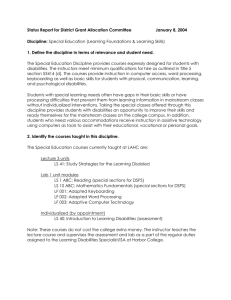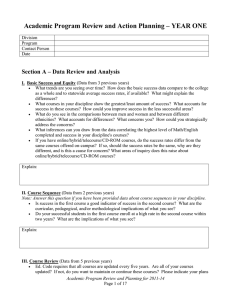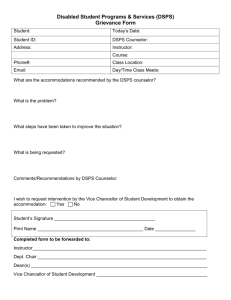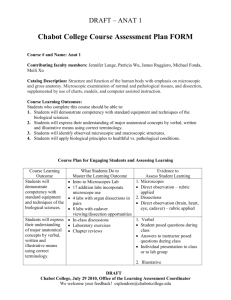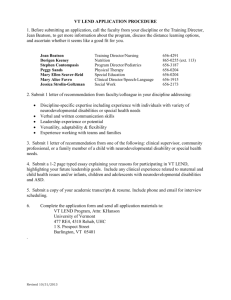Action Plan Progress Report
advertisement
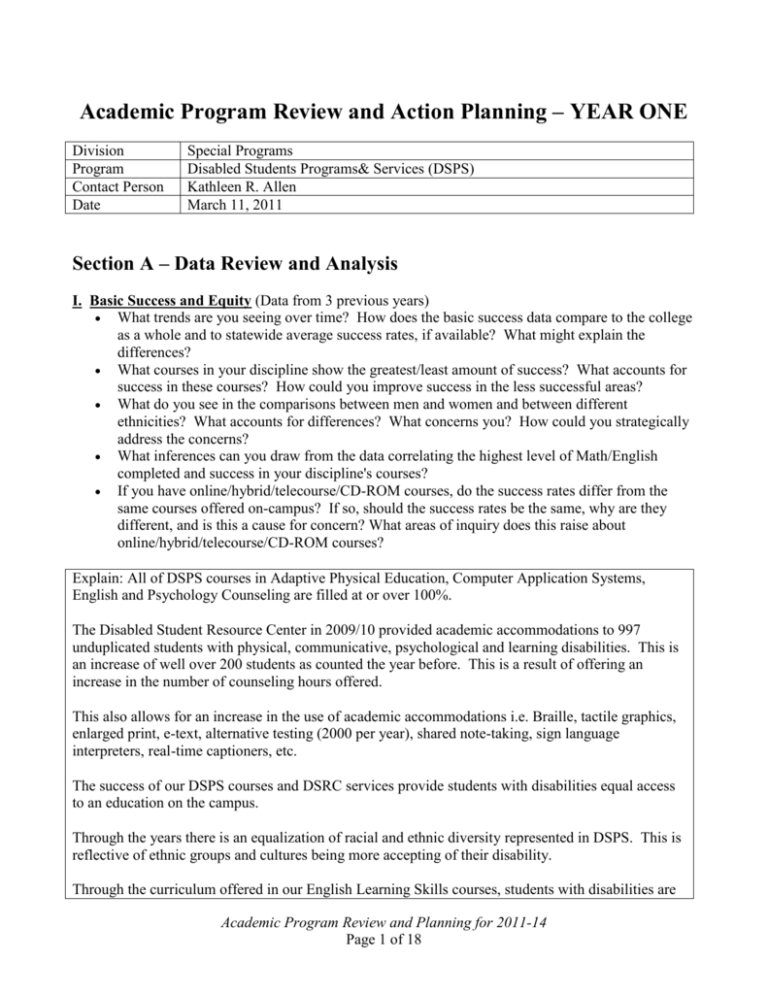
Academic Program Review and Action Planning – YEAR ONE Division Program Contact Person Date Special Programs Disabled Students Programs& Services (DSPS) Kathleen R. Allen March 11, 2011 Section A – Data Review and Analysis I. Basic Success and Equity (Data from 3 previous years) What trends are you seeing over time? How does the basic success data compare to the college as a whole and to statewide average success rates, if available? What might explain the differences? What courses in your discipline show the greatest/least amount of success? What accounts for success in these courses? How could you improve success in the less successful areas? What do you see in the comparisons between men and women and between different ethnicities? What accounts for differences? What concerns you? How could you strategically address the concerns? What inferences can you draw from the data correlating the highest level of Math/English completed and success in your discipline's courses? If you have online/hybrid/telecourse/CD-ROM courses, do the success rates differ from the same courses offered on-campus? If so, should the success rates be the same, why are they different, and is this a cause for concern? What areas of inquiry does this raise about online/hybrid/telecourse/CD-ROM courses? Explain: All of DSPS courses in Adaptive Physical Education, Computer Application Systems, English and Psychology Counseling are filled at or over 100%. The Disabled Student Resource Center in 2009/10 provided academic accommodations to 997 unduplicated students with physical, communicative, psychological and learning disabilities. This is an increase of well over 200 students as counted the year before. This is a result of offering an increase in the number of counseling hours offered. This also allows for an increase in the use of academic accommodations i.e. Braille, tactile graphics, enlarged print, e-text, alternative testing (2000 per year), shared note-taking, sign language interpreters, real-time captioners, etc. The success of our DSPS courses and DSRC services provide students with disabilities equal access to an education on the campus. Through the years there is an equalization of racial and ethnic diversity represented in DSPS. This is reflective of ethnic groups and cultures being more accepting of their disability. Through the curriculum offered in our English Learning Skills courses, students with disabilities are Academic Program Review and Planning for 2011-14 Page 1 of 18 successful in math and English courses required for AA/AS degrees and transfer. Every year DSPS sees an increase in the number of men and women achieving their education goals of earning certificates, AA/AS degrees and transfer to a four-year college. The DSPS Psychology Counseling 20 course encourages and trains students to complete assignments on Blackboard. It has become apparent that the students who use Blackboard are more successful in the course. The students who feel more comfortable turning in hard copies are not jeopardized but they still do not do as well. II. Course Sequence (Data from 2 previous years) Note: Answer this question if you have been provided data about course sequences in your discipline. Is success in the first course a good indicator of success in the second course? What are the curricular, pedagogical, and/or methodological implications of what you see? Do your successful students in the first course enroll at a high rate in the second course within two years? What are the implications of what you see? Explain: English 116 “Learning Skills-Diagnostic Clinic,” In this course Students are determined eligible for learning disability services. The students are provided with recommendations for courses and accommodations that would benefit their academic success. English 117 “Learning Skills-Reading,” students usually enroll in this course for 2 semesters. The first semester the students are trained on phonics. In the second semester they work on reading comprehension . Upon completion there are clear indications whether a student will be successful in an academic path. Students then take English 118A, “Learning Skills-Reading and Writing”. Since we offer 2 sections of this course, students may be required to wait to take English 118B, “Learning Skills-Writing and Reading”, only one section is offered. 90% of the students that enroll in this course are successful and move on to English 101A or 102. Since so many of students with disabilities have difficulty in mathematics, it is necessary for students to repeat English 119, “Learning Skills-Problem Solving.” To alleviate this, it is critical that we offer this as a 2 semester sequence, English119A and 119B. After the completion of PSCN20, “The College Experience” and PSCN 901-4, “Personal Growth”, more students use academic accommodations through the DSRC and in the community, i.e. State Department of Rehabilitation, Community Resources for Independent Living, etc. III. Course Review (Data from 5 previous years) Ed. Code requires that all courses are updated every five years. Are all of your courses updated? If not, do you want to maintain or continue these courses? Please indicate your plans Academic Program Review and Planning for 2011-14 Page 2 of 18 in terms of curriculum. Have all of your courses been offered recently? If not, why? Are students counting on courses to complete a program or major when these courses are not being offered? Explain: All of the DSPS courses are updated and have continually been offered. Students count on these courses to develop the necessary skills needed to complete any program major, certificate, degrees offered at Chabot College or transfer to a four-year college. These courses enable students with disabilities to develop proficiency in the use of academic accommodations based on their individual needs. The students become their own advocate regarding these needs. This skill is imperative for success throughout their lives. IV. Budget Summary (Data from 3 previous years) What budget trends do you see in your discipline? What are the implications of these trends? Where is your budget adequate and where is it lacking? What are the consequences on your program, your students, and/or your instruction? What projected long-term (5-10 years) budget needs do you see? You will detail your short-term needs in the action plan that follows. You do not need to cite them here. Explain: With DSPS decreasing budget, equal access will be denied to students with disabilities at Chabot College, in their careers and in the community. With the increase in the requests for the legally mandated Alternate Media Services, it is critical that the program meet the need by hiring a full time person to meet the needed requests. We provide Sign Language Interpreters and Real-Time Captioners to our increasing number of Deaf/Hard of Hearing and Deaf/Blind students. The cost for providing the legally mandated accommodations for these students is always increasing. There is a shortage of individual contracted Sign Language Interpreters and Real-Time Captioners. Out of all the colleges in the Bay Area we pay the lowest hourly rate, despite the fact we raised our rates 3 years ago. As a result we must use agencies to serve these students at a higher cost. Since our courses are filled at or above 100%, our students would greatly benefit by offering more sections of: CAS 100, “Adapted Keyboarding” and CAS 101, “Adaptive Word”- Many students with disabilities start college without the necessary basic computer skills. The colleges’ CAS 72 series courses are offered online, unfortunately our students need more one on one support. English 116,” Learning Skills-Diagnostic Clinic,” - Currently we offer 11 sections during the academic year and 2 sections in the summer. We need to return to offering 12 sections during the Academic Program Review and Planning for 2011-14 Page 3 of 18 academic year and 3 sections in the summer. PSCN 901-4, “Personal Growth”- Are currently filled at 150% to 190%-More sections of this course should be offered To meet the needs of DSPS students. With the decreasing resources despite the increase in the number of students, it is critical that we determine ways with the college to continue to serve the needs of DSPS students with the increase of assistants at the DSRC and increase course offerings. V. Enrollment Data (Data from 2 previous years) Please provide a brief description of: overall enrollment trends; enrollment trends by course; and enrollment trends by time of day and Saturday. Describe what your discipline has done in terms of curriculum or scheduling in the last two years that has effected enrollments. Describe plans or strategies that you have for the near future in terms of curriculum or scheduling that could impact your enrollments. Lastly, look closely at whether the schedule you currently offer provides access to the broader community that your discipline serves at Chabot College—day time, night time, Saturday, distance education, special or targeted communities that would or do enroll in your courses. Explain: Since DSPS courses have continually filled beyond the maximum, the times and days of our courses are appropriate. Where we need to increase offerings is in the evening. Working students are not able to take Adapted Physical Education, CAS (100,101, 102 and 103), English (117, 118A, 118B, 120 and 121) and PSCN 20 in the evening. This puts our evening students with a disability at a disadvantage. They do not have the opportunity to learn the needed basic skills in keyboarding, word, assistive technology, reading, writing, problem-solving and college skills. In the evening the college does not offer an exercise class that is accessible to students with disabilities. Academic Program Review and Planning for 2011-14 Page 4 of 18 VI. Student Learning Outcomes Inventory Acronym Key: SLO = Student Learning Outcome is a general term, for the following three levels of outcomes: CLO = Course-level Outcome, i.e. what a student can do after completing a course PLO= Program-level Outcome, i.e. what a student can do after completing a sequence of courses CWLG = College-wide Learning Goal Percentage of courses in your discipline that have CLOs and rubrics developed:_100% For this information, please see the list of which courses do and do not have CLOs on the SLOAC’s main webpage: http://www.chabotcollege.edu/sloac/default.asp Percentage of courses in your discipline that have the minimum number of CLOs developed: 100% (1 unit = 1 or more CLO, 2 units = 2 or more CLOs, 3 or more units = 3 or more CLOs) For this information, please see the CLO spreadsheet on the SLOAC’s main webpage: http://www.chabotcollege.edu/sloac/default.asp Date the CLO Assessment schedule was submitted: March 2010 For this information, please see the Course-level Outcomes assessment schedules list from the Assessment Progress and Plans webpage: http://www.chabotcollege.edu/sloac/progress.asp Percentage of courses in your discipline that have had all the CLOs assessed within the past three years, as per Chabot’s Assessment policy: 0 For this information, please see Chabot’s Assessment Policy from the SLO/Assessment Guidelines webpage: http://www.chabotcollege.edu/sloac/guidelines.asp Percentage of courses in your discipline that have had all the CLO assessments reflected upon, or discussed with colleagues, within the past three years:100% What questions or investigations arose as a result of these reflections or discussions? Explain: How do we meet students with disabilities needs when our courses are filled over 100%, despite the state advising that our enrollment be at lower levels? We must turn away 20% to 30% of maximum enrollment. How can we support student success when so many of our students are unable to afford textbooks and materials? How can students be successful without the necessary assistive technology being available in our classes? How can we provide Alternate Media materials, i.e. (Braille, Tactile Graphic s, e-text, enlarged print, etc.) without a full-time person to produce these materials? Academic Program Review and Planning for 2011-14 Page 5 of 18 What actions has your discipline determined that might be taken as a result of these reflections, discussions, and insights? Actions planned: Continue the current curriculum for English 116 and PSCN 20 because they are effective. What course-level and programmatic strengths have the assessment reflections revealed? Strengths revealed: After completing English 116 students demonstrate an increased awareness of their learning disability, their appropriate academic accommodations, the appropriate courses and self advocacy strategies. Upon completion of PSCN 20 students understand and use the additional support resources available on campus. They know which courses are required to earn certificates, AA/AS degrees and transfer to a four-year institution. Percentage of programs within your discipline that have established at least two PLOs, and mapped appropriate CLOs to them: 100% For this information, please see the Program-level Outcomes progress page from the Assessment Progress and Plans webpage: http://www.chabotcollege.edu/sloac/progress.asp Which of the CWLGs do your discipline’s CLOs address? ______________________________________________________________________________ In which if any of the College-wide Learning Goals Faculty Inquiry Groups have discipline member(s) participated? BSI Committee ______________________________________________________________________________ Insights gained: When instructors engage students in a more interactive participation the students’ learning outcome is more successful. VII. Academic Learning Support What kinds of academic learning support does your discipline use or require to help students succeed (e.g., tutoring, learning assistants, student assistants, peer advisors, lab support, supplemental instruction, peer-led team learning, peer advisors)? How many hours per semester do you use and/or how many hours per semester do you need? Explain: DSRC Academic Accommodations, Path Learning Connection, WRAC Center, Math Lab, Lab Student Assistants, Support Student Assistants, etc. Our approximately 1000 students require 58,000 hours of academic support per semester. Academic Program Review and Planning for 2011-14 Page 6 of 18 VIII. External Data Cite any relevant external data that affects your program (e.g., labor market data, community demand, employment growth, external accreditation demands, etc.). An increasing number of returning disabled veterans, (Wounded Warriors). An increase in the number of students with disabilities adversely affected by the recession. An increasing number of High school graduates with disabilities enter Chabot College lacking the necessary academic and social skills needed to succeed in college. Academic Program Review and Planning for 2011-14 Page 7 of 18 Section B – Data Summary From what you have learned in your basic data review, what does the information tell you about your program? Overall, what improvements would you like to make to your program? How do you plan to address these concerns? Are there any immediate issues that require immediate attention (e.g., outdated course outlines)? Where appropriate, please cite relevant data in your discussion (e.g., efficiency, persistence, success, FT/PT faculty ratios, SLO/PLO assessment results, external accreditation demands, etc.). Data Summary and Plan of Action Description/Rationale: Due to the decrease in DSPS allocation funding, there has been a significant decrease in services. The DSPS current staffing does not meet our continuing student growth rate. Increase classified staffing by hiring a full-time Alternate Media Technology Specialist, one fulltime or two half–time Computer Lab Specialists, one full-time Office Manager and one full-time Learning Skills Instructional Assistant II. Increase the number of student assistants to work in the DSRC as receptionists, High Tech Lab Assistants and Support Service Assistants. Also, we do not offer enough DSPS course sections to meet enrollment demands. Increase faculty staffing by hiring a full-time Adaptive Physical Education Instructor, Assistive Technology Instructor and a Learning Disability Specialist. Since we are barely meeting student needs now, it is critical to maintain current staffing levels. Also, the data demonstrates that further cuts to DSPS would certainly be severely detrimental to students with disabilities academic learning outcomes. Our students will not succeed with cuts to DSPS. Section C – Action Planning Please propose a two-year plan of action and timeline to address any immediate and/or long-term concern(s). This includes activities to assess the CLO(s) to discover a plan of action. It may also include specific activities that address improving CLO(s) and their assessment, that is to say evaluating the CLO(s) and the assessment activities. Examples of activities include: Research and inquiry project – why is this happening? Innovation and Pilot Projects – this is something I want to try Intervention activities such as support services – this is what I want to do about it Program and curriculum modification – this is what I want to do about it 8 I. Action Plan Timeline: Detail the timeline for accomplishing your goals PLOs and/or Program Goal(s) To provide mandated alternate media materials for students with disabilities academic success. Providing students with disabilities with assistive technology accommodations, thereby supporting students to achieve their educational goals of earning AA/AS Degrees, Certificates and transferring to 4-year colleges. Timeline Fall 2011 2012 Activity Provide students with documented disabilities legally mandated alternate media materials i.e., Braille, tactile graphics, large print, e-text, etc. in an efficient manner. The DSRC critically requires an additional dedicated area specifically used for testing, with 15-20 work stations equipped with computer software and hardware installed with assistive technology. In order to serve our students with their increasing requests for use of Kurzweil 3000, 1000, Dragon Professional and SuperNova during their tests, more testing space and more computer stations are imperative. We have long out grown our Testing Lab with room for 8 students which includes 3 computer stations. Due to the limited testing space with assistive technology, it is Support Needed to Accomplish These Activities* State mandated technology for the production of the materials. Outcome(s) Expected More DSPS students will achieve their educational goals by earning AA/AS Degrees, Certificates and transferring to 4-year colleges. Person(s) Responsible Accomplished? Yes/No/In Progress Alternate Media Technology Specialist Increase the number of stuents using support services and encourage students with a disability to become independent and assertive participants in their own educational process. Ability to provide additional alternative testing for our growing number of students with documented disabilities. More DSPS students will achieve their educational goals by earning AA/AS Degrees, Certificates and transferring to 4-year colleges. Students would have more opportunities to take their tests with the benefit of mandated assistive technology. Increase the number of students using support services and encourage students with a disability to become independent and assertive participants in their own educational process. Increase the success and persistence rates from Basic Skills English (English 117, 118A/B, 119, 120, and 121); CAS (100, 101, 102, and 103) to college level Language Arts, 9 Assistive Technology Instructor YEAR ONE LEAVE BLANK necessary for students to be tested in our small High Tech Center and in the DSRC general area. Both of these areas are not ADA compliant because they are not distraction-free environments since classes are in session at the same time. Each the DSRC provides alternative testing for over 2000 tests per year with more students requesting the use of assistive technology. To provide mandated assistive technology for students with disabilities academic success. 2012 Dolphin Hands Free is a screen reader that interfaces with Dragon Professional. This allows visually impaired students that have physical limitations involving their arms or hands us computers to successfully complete their course work. We currently have an increasing number of students making requests for this software. Computer Application Systems and Mathematic courses for students with documented disabilities. This benefits our blind/visually-impaired students with physical disabilities utilize the computer in completing their tests and coursework. More DSPS students will achieve their educational goals by earning AA/AS Degrees, Certificates and transferring to 4-year colleges. Assistive Technology Instructor Increase the number of students using support services and encourage students with a disability to become independent and assertive participants in their own educational process. Definitions of terms: Program Goal = A general statement of what the program hopes to accomplish, for the long-term. It may be in qualitative (narrative) rather than quantitative (numeric) terms. It may include the integration of several program outcomes, or relate to class scores, credits, units, course completion, retention term to term, progression to next course/level, program completion, degree and certificate completion, transfer, success/scores on licensure exams, job placement, attitudes, fundraising, media promotion, etc. 10 PLO = Program-level Outcome, i.e., what students can do, what knowledge they have, after completing a sequence of courses. It is a subset of the Program Goals, related to student learning. *Types of Support Needed to Accomplish Activities: Training or workshops Publications, library, resources Guidance to support research and/or inquiry projects Technology I. X X X X Strategic Plan Goals and Summaries: Which Strategic Plan goals and strategies does your action plan support? Awareness and Access Increase familiarity with Chabot Reach out to underrepresented populations X Promote early awareness and college readiness to youth and families Multiple ways to deliver instruction and services for all X Student Success Strengthen basic skills development X Identify and provide a variety of career paths X Increase success for all students in our diverse community X Assess student learning outcomes to improve and expand instruction and services X Community Partnership Increase experiential learning opportunities Initiate/expand partnerships among the college, businesses and community organizations X Promote faculty and staff involvement in college and community activities Engage the community in campus programs and events Vision Leadership and Innovation Improve institutional effectiveness X Streamline academic and student support services X Professional development to support teaching, learning and operational needs X Support effective communication both in the college and the community X 11 X Provide safe, secure and up-to-date facilities and technology 12 Program Review and Action Planning – YEAR TWO Action Plan Progress Report Division Program Contact Person Date Audience: IPBC; Program Review Committee; Deans/Unit Administrators; Budget Committee Purpose: To provide evidence of progress on from previous year and to provide input into planning for subsequent years. Instructions: If you have completed your unit plan last year, please update your timeline and answer the questions below. If you are updating/changing your timeline, list the appropriate year in which revisions were made. IA. Problem Statement: Summarize your Program Review Year One conclusions. IB. Analysis: If there are any new data or conclusions, what is the basis for these new conclusions? II. List your accomplishments: How do they relate to your program review and PLO work? Please cite any relevant data elements (e.g., efficiency, persistence, success, FT/PT faculty ratios, SLO/PLO assessment results, external accreditation demands, etc.). III. Student Learning Outcomes Inventory Update Acronym Key: SLO = Student Learning Outcome is a general term, for the following three levels of outcomes: CLO = Course-level Outcome, i.e. what a student can do after completing a course PLO= Program-level Outcome, i.e. what a student can do after completing a sequence of courses CWLG = College-wide Learning Goal 13 Percentage of courses in your discipline that have CLOs and rubrics developed: For this information, please see the list of which courses do and do not have CLOs on the SLOAC’s main webpage: http://www.chabotcollege.edu/sloac/default.asp Percentage of courses in your discipline that have the minimum number of CLOs developed: (1 unit = 1 or more CLO, 2 units = 2 or more CLOs, 3 or more units = 3 or more CLOs) For this information, please see the CLO spreadsheet on the SLOAC’s main webpage: http://www.chabotcollege.edu/sloac/default.asp Date the CLO Assessment schedule was submitted: For this information, please see the Course-level Outcomes assessment schedules list from the Assessment Progress and Plans webpage: http://www.chabotcollege.edu/sloac/progress.asp Percentage of courses in your discipline that have had all the CLOs assessed within the past three years, as per Chabot’s Assessment policy: _______ For this information, please see Chabot’s Assessment Policy from the SLO/Assessment Guidelines webpage: http://www.chabotcollege.edu/sloac/guidelines.asp Percentage of courses in your discipline that have had all the CLO assessments reflected upon, or discussed with colleagues, within the past three years_______ What questions or investigations arose as a result of these reflections or discussions? Explain: What actions has your discipline determined that might be taken as a result of these reflections, discussions, and insights? Actions planned: What course-level and programmatic strengths have the assessment reflections revealed? Strengths revealed: Percentage of programs within your discipline that have established at least two PLOs, and mapped appropriate CLOs to them:________ For this information, please see the Program-level Outcomes progress page from the Assessment Progress and Plans webpage: http://www.chabotcollege.edu/sloac/progress.asp Which of the CWLGs do your discipline’s CLOs address? _________________________________________________________________________ _________________________________________________________________________ 14 In which if any of the College-wide Learning Goals Faculty Inquiry Groups have discipline member(s) participated? _________________________________________________________________________ _________________________________________________________________________ Insights gained: VII. Academic Learning Support What kinds of academic learning support does your discipline use or require to help students succeed (e.g., tutoring, learning assistants, student assistants, peer advisors, lab support, supplemental instruction, peer-led team learning, peer advisors)? How many hours per semester do you use and/or how many hours per semester do you need? Explain: IV. External Data Cite any relevant external data that affects your program (e.g., labor market data, community demand, employment growth, external accreditation demands, etc.). 15 V. Action Plan Timeline Update: Cut and paste your previous timeline from Year One and update the “Accomplished?” column. List any new PLOs or program goals and activities you may have in the second chart. PLOs and/or Program Goal(s) from Year One Timeline Activity Support Needed to Accomplish these Activities* Outcome(s) Expected Person(s) Responsible Accomplished? Yes/No/In Progress New PLOs and/or Program Goal(s) Timeline Activity Support Needed to Accomplish these Activities* Outcome(s) Expected Person(s) Responsible Accomplished? Yes/No/In Progress YEAR TWO LEAVE BLANK 16 Definitions of terms: 1. Program Goal = A general statement of what the program hopes to accomplish, for the long-term. It may be in qualitative (narrative) rather than quantitative (numeric) terms. It may include the integration of several program outcomes, or relate to class scores, credits, units, course completion, retention term to term, progression to next course/level, program completion, degree and certificate completion, transfer, success/scores on licensure exams, job placement, attitudes, fundraising, media promotion, etc. PLO = Program-level Outcome, i.e., what students can do, what knowledge they have, after completing a sequence of courses. It is a subset of the Program Goals, related to student learning. *Types of Support Needed to Accomplish Activities: Training or workshops Publications, library, resources Guidance to support research and/or inquiry projects Technology 12 Program Review and Action Planning – YEAR THREE Final Summary Report Division Program Contact Person Date I. Reflect upon the last three years' analysis and activities. II. Briefly summarize the accomplishments of the discipline, and how they relate to the review of the program, the program-level outcomes (PLOs) and course-level outcomes (CLOs). III. Please list what best practices (e.g., strategies, activities, intervention, elements, etc.) you would recommend? What was challenging? Was there a barrier(s) to success? Best practices: Challenges/Barriers to Success: IV. Next Steps: Recommendations for program and institutional improvement. Program Improvement: Institutional Improvement: 13
